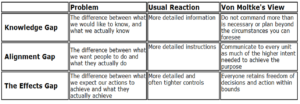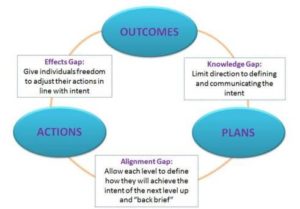By Simon Fawkes, Director – Business to Markets Ltd
Most organisations suffer from too much planning that does not achieve the desired results. Increase the size of the organisation, the number of management layers and departments, and the problem only gets worse. More planning and more detailed plans are not the answer to address the issue of improving the implementation of strategy!
Stephen Bungay’s latest book “The Art of Action” shows how leaders close the gaps between Plans, Actions and Results.
The three main components of planning outlined in the book are Plans, Actions and Outcome or Results. You develop your plan to get you from where you are NOW to WHERE you want to be, defined by the Outcome you want to achieve. The Actions then show HOW you will get there.
There are three critical gaps you must recognise and then handle correctly. The Prussian general von Moltke outlined a way of closing the three gaps in his Memoire of 1868.
His solution to each gap runs counter to our intuition and to common practice. To overcome the Alignment Gap, he recommends cascading plans, united by a common intent and in more detail at lower levels. As for the Effects Gap, to what extent do you need to reduce autonomy to achieve greater alignment? Von Moltke’s insight is that there is no choice to make. “Alignment needs to be achieved around intent and autonomy should be granted around actions.”
Intent is what to achieve and why. Actions are how to achieve the intent. The difference between strategy development and strategy execution disappears. It is replaced by a “thinking – doing” cycle of learning and adapting. You do not need to know everything, but you do need to be clear about the intent and to communicate this clearly.
We can now jump to Jack Welch, Chairman and CEO of GE in the 1980’s. Bungay quotes a letter published in Fortune magazine that had a major impact on Welch, who called the approach “planful opportunism.” The salient part of the letter is the observation that the Prussian general staff “did not expect a plan of operations to survive the first encounter with the enemy. They set only the broadest objectives and emphasised seizing unforeseen circumstances as they arose.” Bungay’s term is “directed opportunism”.
The “back brief” is critically important. Firstly, it checks the understanding of the intent. Secondly and more importantly, the superior gains clarity about the implications of the intent and this may lead to changes. Thirdly, it facilitates alignment across the organisation.
Bungay stresses that “what cannot be made simple cannot be made clear and what is not clear will not get done.” This is a critical message that should underpin successful strategy implementation in your business.
Simon Fawkes is a “reformed engineer”, linguist and B2B marketing specialist, who helps hi-tech companies grow faster in niche export markets. See www.globalmarketinginsight.com and www.b2m.co.nz.

